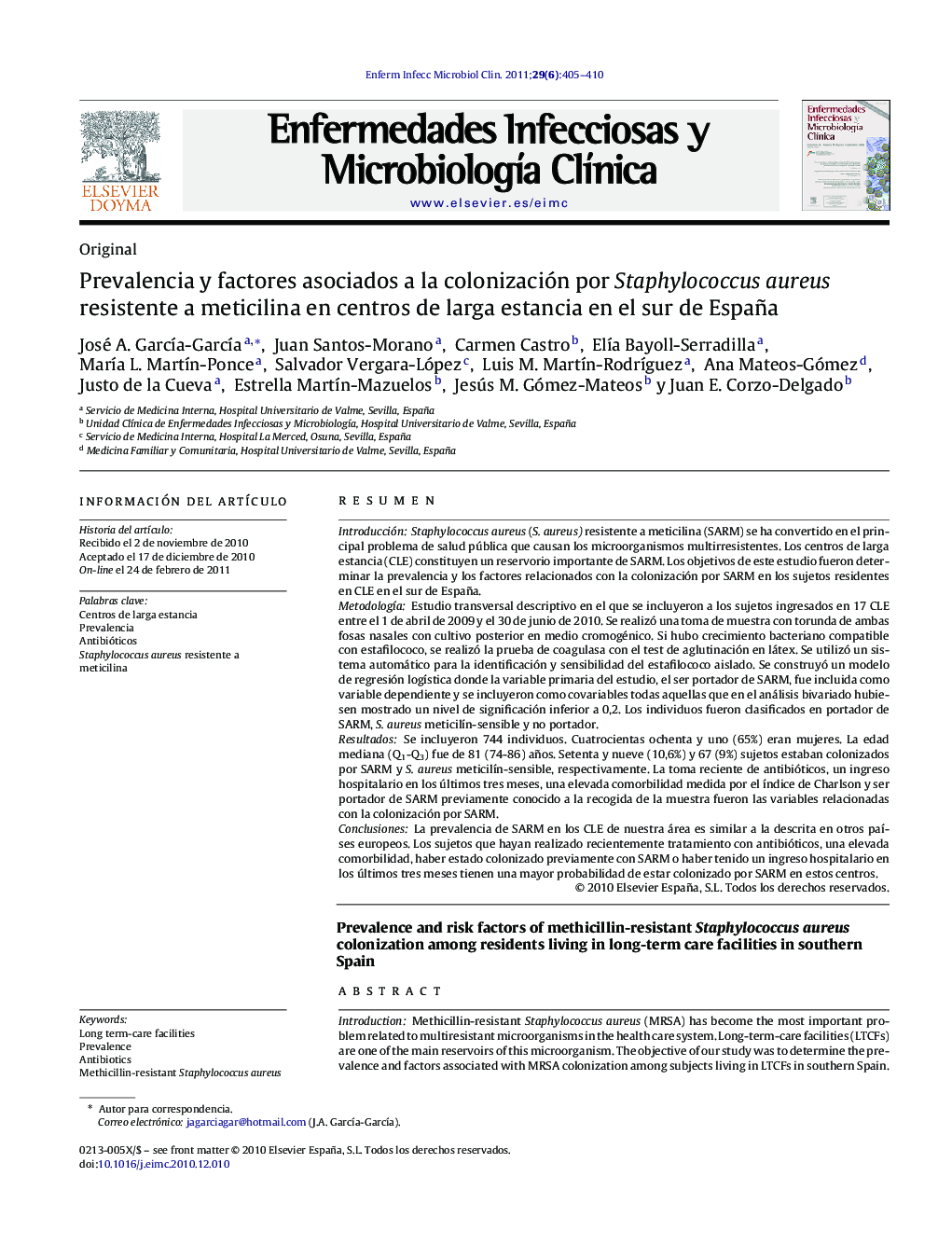| کد مقاله | کد نشریه | سال انتشار | مقاله انگلیسی | نسخه تمام متن |
|---|---|---|---|---|
| 3401865 | 1222687 | 2011 | 6 صفحه PDF | دانلود رایگان |

ResumenIntroducciónStaphylococcus aureus (S. aureus) resistente a meticilina (SARM) se ha convertido en el principal problema de salud pública que causan los microorganismos multirresistentes. Los centros de larga estancia (CLE) constituyen un reservorio importante de SARM. Los objetivos de este estudio fueron determinar la prevalencia y los factores relacionados con la colonización por SARM en los sujetos residentes en CLE en el sur de España.MetodologíaEstudio transversal descriptivo en el que se incluyeron a los sujetos ingresados en 17 CLE entre el 1 de abril de 2009 y el 30 de junio de 2010. Se realizó una toma de muestra con torunda de ambas fosas nasales con cultivo posterior en medio cromogénico. Si hubo crecimiento bacteriano compatible con estafilococo, se realizó la prueba de coagulasa con el test de aglutinación en látex. Se utilizó un sistema automático para la identificación y sensibilidad del estafilococo aislado. Se construyó un modelo de regresión logística donde la variable primaria del estudio, el ser portador de SARM, fue incluida como variable dependiente y se incluyeron como covariables todas aquellas que en el análisis bivariado hubiesen mostrado un nivel de significación inferior a 0,2. Los individuos fueron clasificados en portador de SARM, S. aureus meticilín-sensible y no portador.ResultadosSe incluyeron 744 individuos. Cuatrocientas ochenta y uno (65%) eran mujeres. La edad mediana (Q1-Q3) fue de 81 (74-86) años. Setenta y nueve (10,6%) y 67 (9%) sujetos estaban colonizados por SARM y S. aureus meticilín-sensible, respectivamente. La toma reciente de antibióticos, un ingreso hospitalario en los últimos tres meses, una elevada comorbilidad medida por el índice de Charlson y ser portador de SARM previamente conocido a la recogida de la muestra fueron las variables relacionadas con la colonización por SARM.ConclusionesLa prevalencia de SARM en los CLE de nuestra área es similar a la descrita en otros países europeos. Los sujetos que hayan realizado recientemente tratamiento con antibióticos, una elevada comorbilidad, haber estado colonizado previamente con SARM o haber tenido un ingreso hospitalario en los últimos tres meses tienen una mayor probabilidad de estar colonizado por SARM en estos centros.
IntroductionMethicillin-resistant Staphylococcus aureus (MRSA) has become the most important problem related to multiresistant microorganisms in the health care system. Long-term-care facilities (LTCFs) are one of the main reservoirs of this microorganism. The objective of our study was to determine the prevalence and factors associated with MRSA colonization among subjects living in LTCFs in southern Spain.MethodsDuring the period from 1st April 2009 to 30th June 2010, all subjects living in 17 LTCFs of our area were included in a cross-sectional study. Patients were screened by using nasal swabs and these were cultured in a chromogenic media. Suspected S. aureus colonies were identified by the latex agglutination test. Testing for antimicrobial identification and susceptibility was performed by an automated system. A logistic regression model was built, in which to be colonized by MRSA was the dependent variable, and covariates were entered if a difference with P < .2 was detected in the bivariate analysis. Residents were classified as MRSA carriers, methicillin-susceptible S. aureus carriers and non-carriers.ResultsSeven hundreds and forty-four subjects were included. There were 481 (65%) females. The median (Q1-Q3) age was 81 (74-86) years. Seventy-nine (10.6%) and 67 (9%) were colonized by MRSA and methicillin-susceptible S. aureus, respectively. Significant risk factors for MRSA carriers were recent antibiotic use, previous hospital admission in the last three months, a high comorbidity measured by Charlson index and a history of colonization by MRSA.ConclusionsThe prevalence of MRSA colonization in the LTCFs of our area is similar to that described in others European countries. In our institutions, subjects with recent antibiotic use, a high comorbidity, a history of MRSA colonization and a hospital admission in the last three months are more susceptible to be colonized by MRSA.
Journal: Enfermedades Infecciosas y Microbiología Clínica - Volume 29, Issue 6, June–July 2011, Pages 405–410